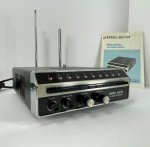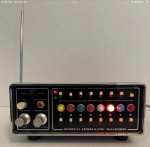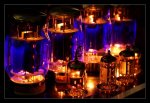I got into radio around the 6th grade. My friend's father was an engineer for a timber company and had a Chevy Celebrity wagon with a CB, Midland lowband radio, 800mhz EF Johnson duplex radio phone and a Uniden BC-760xlt. We'd spend hours listening to local police and other users out in the driveway. He lived on a high hill, so we could hear everything in the surrounding valley.
When his father picked up a new Ford Explorer, he let us have the scanner. My friend wasn't as radio crazy as I was, so he let me borrow it for weeks at a time.
Local PD and sheriff were analog UHF conventional. Fire was all VHF simplex remote base, which was a PITA to listen to. I discovered a few years later that the FD used UHF links to carry the voted audio back, so during structure fires I'd tune into the 453.xxx/458.xxx link frequencies. The 2175hz idle tone was annoying, but it was the only way to monitor fireground audio from a distance.
There was a weekly ham swapmeet bulletin board which was announced on a local repeater. One day the gentleman advertised hundreds of complete Motorola Mitrek radios for $20/each. My dad drove us out to the radio shop and we bought a couple. The seller installed some MURS channel elements into the radios as a nice bonus. We set em up as base stations at our homes and would chat back and forth.
I wanted a portable radio, so I mowed lawns for months and saved up. Picked up a pair of Radio Shack PRS-102s, which were rebadged Motorola Handi-Com GMRS radios. I also bought the optional CTCSS boards, spring belt clips, Radius speaker mics and stubby antennas. Several businesses in town had grandfathered use of some GMRS frequencies, and one even had a phone patch on it. Made for interesting listening.
One of the radios was stolen a year later, so I rode my bike to a local radio shop and asked what they had for sale. Ended up with a cheap pair of Kenwood TK-340s, which were a massive improvement. They had 16 channels, scan and FPP! You had to remove a decal on the rear and short out two pins while you powered on the radio, and you could program channels using the rotary encoder. Still have the 340s to this day.
There was an odd frequency of 462.900 with a long 10-tone sequence every 30 seconds. We started monitoring it regularly and discovered people would call in and leave messages. We'd hear 2-tone, 5/6 tone, POCSAG, and DTMF signaling followed by voice messages. The messages would repeat, but the signal was half as strong. They'd repeat a third time, but it was usually too weak to copy.
Someone called in once and mentioned the number they'd called - naturally our curiosity got the better of us and we ended up mapping out all the numbers on that prefix which connected to the voice paging system. One number sent both 5/6-tone and DTMF so it was easier to hear, so we'd call that and leave messages for each other. Eventually the "owner" of that number called his own number and left a message. "I think your kids have the wrong number, or you have a duplicate pager. We then figured out it was a voice paging system, and stopped using it to page eachother.
Years later I was telling this story to the father of a girl I was dating. Turns out it was HIS number. He was dying of laughter. The reason for 5/6 and DTMF was 5/6 went to his pager and DTMF triggered the horn/lights relay on his work truck, so it would play the message over a PA speaker while he was working on a tower. The reason for the weak 2nd and 3rd transmissions was additional transmitters located in two different valleys. You can hear bits of that 10-tone sequence
@ 8:29 in the recording below
The local police used Kenwood TK-330 handhelds with DTMF post signaling and Motorola Spectra mobiles. They had one transmit site with a few voting receivers scattered around town. Apparently they'd turned reverse burst off a the squelch crashes were pretty loud.
The sheriff (extra loud PL on the recording below) used Motorola Saber 3s and Spectras. Surprisingly, the sheriff dispatchers had no wireline/console priority to the repeaters. They dispatched via control stations hooked up to consoles and had an odd 2-tone keying sequence (not to be confused with the regular console tones you hear in the video below.)
PRS-102
 My first scanner was a Channel Master 10-channel model that I purchased as a teenager while I still lived with my parents. When I brought it home, my Dad was very angry that I would spend such a large amount of money on a “fancy radio”. It didn’t take long for him to become hooked to listening to it. In fact, he bought his own soon afterwards.
My first scanner was a Channel Master 10-channel model that I purchased as a teenager while I still lived with my parents. When I brought it home, my Dad was very angry that I would spend such a large amount of money on a “fancy radio”. It didn’t take long for him to become hooked to listening to it. In fact, he bought his own soon afterwards.





